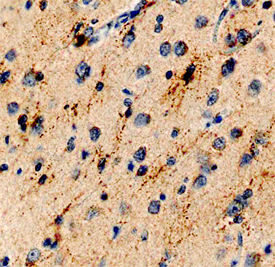Human SALM3/LRFN4 Antibody Summary
Cys17-Leu518
Accession # Q6PJG9
Applications
Please Note: Optimal dilutions should be determined by each laboratory for each application. General Protocols are available in the Technical Information section on our website.
Scientific Data
 View Larger
View Larger
SALM3/LRFN4 in Human Brain. SALM3/LRFN4 was detected in immersion fixed paraffin-embedded sections of human brain (cerebellum) using Mouse Anti-Human SALM3/LRFN4 Monoclonal Antibody (Catalog # MAB5445) at 15 µg/mL overnight at 4 °C. Before incubation with the primary antibody, tissue was subjected to heat-induced epitope retrieval using Antigen Retrieval Reagent-Basic (Catalog # CTS013). Tissue was stained using the Anti-Mouse HRP-DAB Cell & Tissue Staining Kit (brown; Catalog # CTS002) and counterstained with hematoxylin (blue). View our protocol for Chromogenic IHC Staining of Paraffin-embedded Tissue Sections.
Reconstitution Calculator
Preparation and Storage
- 12 months from date of receipt, -20 to -70 °C as supplied.
- 1 month, 2 to 8 °C under sterile conditions after reconstitution.
- 6 months, -20 to -70 °C under sterile conditions after reconstitution.
Background: SALM3/LRFN4
Synaptic adhesion-like molecule 3 (SALM3; also leucine-rich repeat and fibronectin type-III domain-containing protein 4 (LRFN4) is an approximately 90 kDa member of the Lrfn family of type I transmembrane glycoproteins (1). Human SALM3 is synthesized as a 635 amino acid (aa) precursor that contains a 16 aa signal sequence, a 502 aa extracellular domain (ECD), a 21 aa transmembrane region, and a 96 aa cytoplasmic region. The ECD consists of seven leucine-rich repeats (LRR), an IgC2-like domain, and a fibronectin type-III domain, tandemly aligned in that order (1 - 2). In addition, there are six potential sites for N-linked glycosylation. The C-terminal region contains an intracellular PDZ binding domain, which is conserved among SALMs 1 - 3, but is absent in SALMs 4 and 5 (3). Mature human SALM3 shares 97% aa sequence identity with mature mouse SALM3. Northern blot analysis showed that in mice, SALM3 is strongly expressed in the adult brain and is also present in the adult testis (1). It is distributed throughout the neuron, including the growth cone (3). In the developing mouse embryo, a temporal expression profile blot revealed a general increment of expression around E10.5, with weak expression detected before E10.5 (1). SALM3, like the other SALMs, promotes neurite outgrowth (3). Specifically, the SALMs modify total outgrowth and neurite branching (3). SALM3 may also be involved in synapse formation, synaptic maintenance, and other cellular interactions (3).
- Morimura, N. et al. (2006) Gene 380:72.
- Wang, C.Y. et al. (2006) J. Neurosci. 26:2174.
- Wang, P.Y. et al. (2008) Mol. Cell. Neurosci. 39:83.
Product Datasheets
Citation for Human SALM3/LRFN4 Antibody
R&D Systems personnel manually curate a database that contains references using R&D Systems products. The data collected includes not only links to publications in PubMed, but also provides information about sample types, species, and experimental conditions.
1 Citation: Showing 1 - 1
-
High SALM3 Expression in Tumor Cells and Fibroblasts Is Correlated with Poor Prognosis in Gastric Cancer Patients
Authors: Y Liu, X Chen, X Chen, X Yang, Q Song, H Wu
Dis. Markers, 2019-04-04;2019(0):8282414.
Species: Human
Sample Types: Whole Tissue
Applications: IHC-P
FAQs
No product specific FAQs exist for this product, however you may
View all Antibody FAQsReviews for Human SALM3/LRFN4 Antibody
There are currently no reviews for this product. Be the first to review Human SALM3/LRFN4 Antibody and earn rewards!
Have you used Human SALM3/LRFN4 Antibody?
Submit a review and receive an Amazon gift card.
$25/€18/£15/$25CAN/¥75 Yuan/¥2500 Yen for a review with an image
$10/€7/£6/$10 CAD/¥70 Yuan/¥1110 Yen for a review without an image

